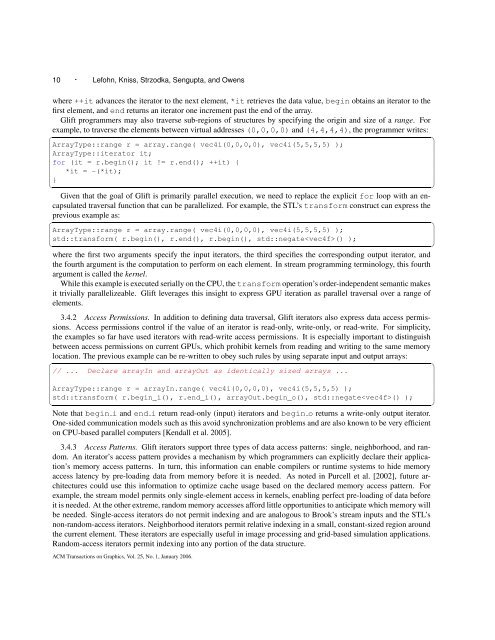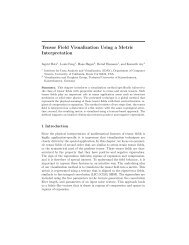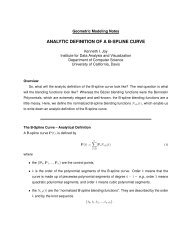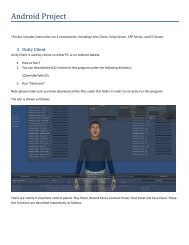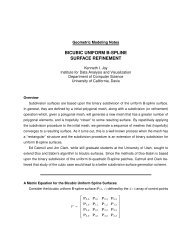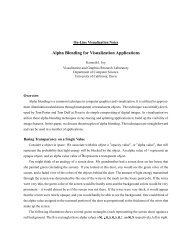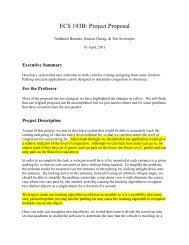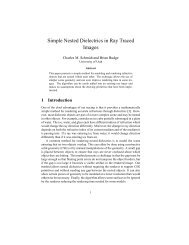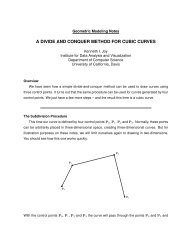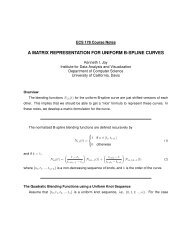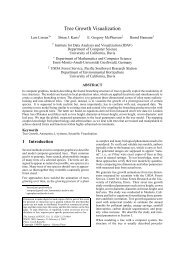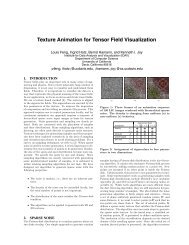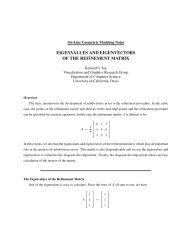Paper - IDAV: Institute for Data Analysis and Visualization
Paper - IDAV: Institute for Data Analysis and Visualization
Paper - IDAV: Institute for Data Analysis and Visualization
You also want an ePaper? Increase the reach of your titles
YUMPU automatically turns print PDFs into web optimized ePapers that Google loves.
10 · Lefohn, Kniss, Strzodka, Sengupta, <strong>and</strong> Owenswhere ++it advances the iterator to the next element, *it retrieves the data value, begin obtains an iterator to thefirst element, <strong>and</strong> end returns an iterator one increment past the end of the array.Glift programmers may also traverse sub-regions of structures by specifying the origin <strong>and</strong> size of a range. Forexample, to traverse the elements between virtual addresses (0,0,0,0) <strong>and</strong> (4,4,4,4), the programmer writes:✞ArrayType::range r = array.range( vec4i(0,0,0,0), vec4i(5,5,5,5) );ArrayType::iterator it;<strong>for</strong> (it = r.begin(); it != r.end(); ++it) {*it = -(*it);}✝Given that the goal of Glift is primarily parallel execution, we need to replace the explicit <strong>for</strong> loop with an encapsulatedtraversal function that can be parallelized. For example, the STL’s trans<strong>for</strong>m construct can express theprevious example as:✞ArrayType::range r = array.range( vec4i(0,0,0,0), vec4i(5,5,5,5) );std::trans<strong>for</strong>m( r.begin(), r.end(), r.begin(), std::negate() );✝where the first two arguments specify the input iterators, the third specifies the corresponding output iterator, <strong>and</strong>the fourth argument is the computation to per<strong>for</strong>m on each element. In stream programming terminology, this fourthargument is called the kernel.While this example is executed serially on the CPU, the trans<strong>for</strong>m operation’s order-independent semantic makesit trivially parallelizeable. Glift leverages this insight to express GPU iteration as parallel traversal over a range ofelements.3.4.2 Access Permissions. In addition to defining data traversal, Glift iterators also express data access permissions.Access permissions control if the value of an iterator is read-only, write-only, or read-write. For simplicity,the examples so far have used iterators with read-write access permissions. It is especially important to distinguishbetween access permissions on current GPUs, which prohibit kernels from reading <strong>and</strong> writing to the same memorylocation. The previous example can be re-written to obey such rules by using separate input <strong>and</strong> output arrays:✞// ... Declare arrayIn <strong>and</strong> arrayOut as identically sized arrays ...ArrayType::range r = arrayIn.range( vec4i(0,0,0,0), vec4i(5,5,5,5) );std::trans<strong>for</strong>m( r.begin_i(), r.end_i(), arrayOut.begin_o(), std::negate() );✝Note that begin i <strong>and</strong> end i return read-only (input) iterators <strong>and</strong> begin o returns a write-only output iterator.One-sided communication models such as this avoid synchronization problems <strong>and</strong> are also known to be very efficienton CPU-based parallel computers [Kendall et al. 2005].3.4.3 Access Patterns. Glift iterators support three types of data access patterns: single, neighborhood, <strong>and</strong> r<strong>and</strong>om.An iterator’s access pattern provides a mechanism by which programmers can explicitly declare their application’smemory access patterns. In turn, this in<strong>for</strong>mation can enable compilers or runtime systems to hide memoryaccess latency by pre-loading data from memory be<strong>for</strong>e it is needed. As noted in Purcell et al. [2002], future architecturescould use this in<strong>for</strong>mation to optimize cache usage based on the declared memory access pattern. Forexample, the stream model permits only single-element access in kernels, enabling perfect pre-loading of data be<strong>for</strong>eit is needed. At the other extreme, r<strong>and</strong>om memory accesses af<strong>for</strong>d little opportunities to anticipate which memory willbe needed. Single-access iterators do not permit indexing <strong>and</strong> are analogous to Brook’s stream inputs <strong>and</strong> the STL’snon-r<strong>and</strong>om-access iterators. Neighborhood iterators permit relative indexing in a small, constant-sized region aroundthe current element. These iterators are especially useful in image processing <strong>and</strong> grid-based simulation applications.R<strong>and</strong>om-access iterators permit indexing into any portion of the data structure.ACM Transactions on Graphics, Vol. 25, No. 1, January 2006.☎✆☎✆☎✆


